Borgo Medievale di Torino - Medieval village of Turin [it] [en]
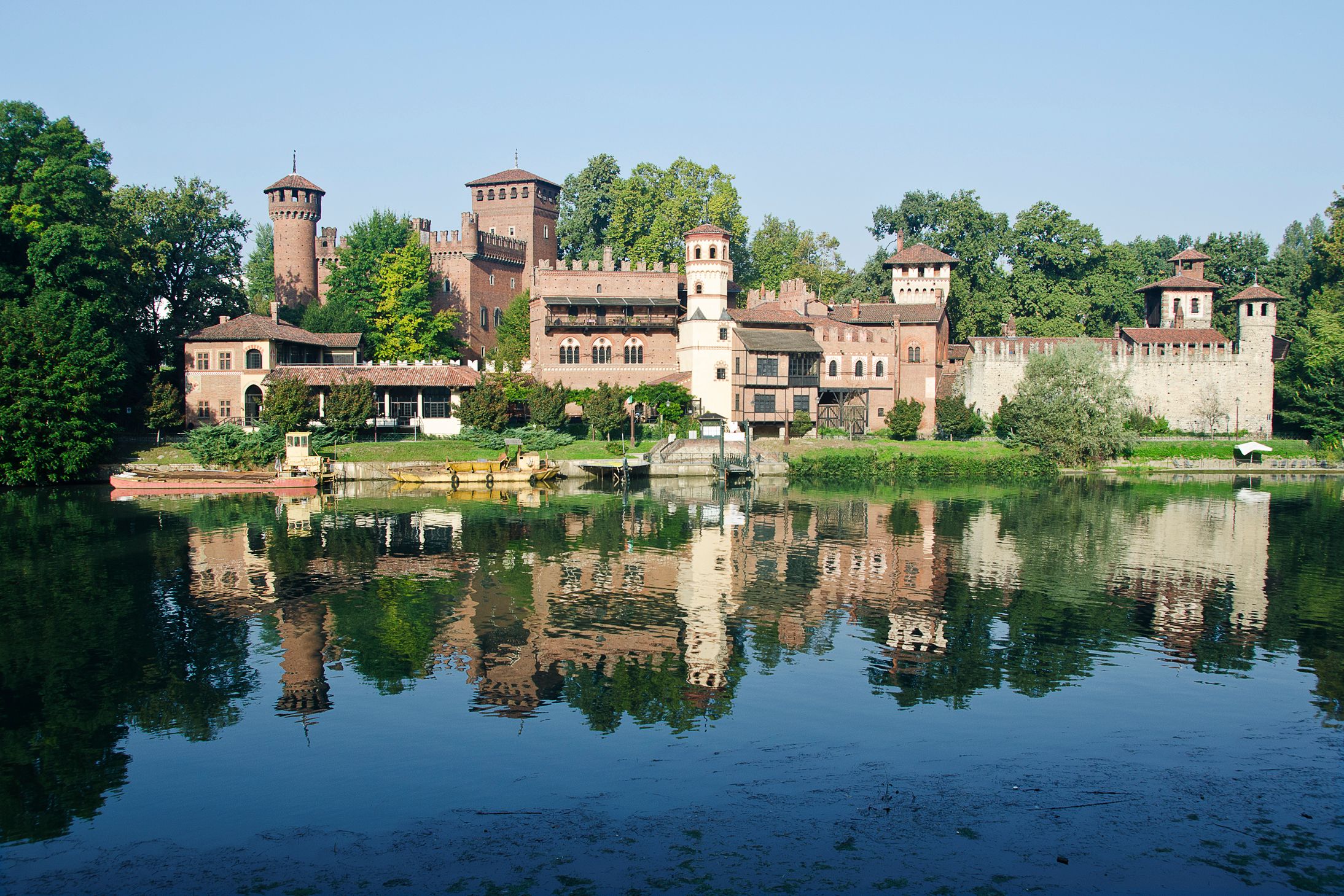
[it] Il Borgo Medievale di Torino è uno dei più significativi prodotti di una corrente culturale, il neomedievismo ottocentesco, che, pur con forme e finalità differenti, ha lasciato in tutta Europa importanti testimonianze nell'architettura, nelle arti, nella letteratura e nel gusto e che ebbe particolare fortuna a Torino e in Piemonte. L'invenzione del Medioevo nella cultura dell'Ottocento, Napoli, 1993).
L'esposizione torinese si propose di offrire una sezione artistico-architettonica; a questo scopo fu costituita la Sezione di Arte Antica, una commissione interdisciplinare formata da letterati, storici, artisti, architetti, archivisti, esperti di oggetti d'arte, che iniziarono a riunirsi nel gennaio del 1882, sotto la presidenza di Ferdinando Scarampi di Villanova, per elaborare un progetto di padiglione. Iniziarono così le ricerche preliminari alla realizzazione del Borgo Medioevale, costituito da un villaggio e un castello turrito. Prodotto d'invenzione nel suo insieme, ogni elemento architettonico, decorativo e di arredo del Borgo è riprodotto con precisione filologica da modelli originali del secolo XV, rintracciabili all'epoca in Piemonte e Valle d'Aosta, rilevati e studiati personalmente dai componenti della Commissione.
[en] The Medieval Borgo of Turin is one of the most significant products of a cultural current, the nineteenth-century neo-medievalism, which, although with different forms and purposes, has left important evidence in architecture, arts, literature and taste throughout Europe. he was particularly lucky in Turin and Piedmont. The invention of the Middle Ages in the nineteenth century culture, Naples, 1993).
The Turin exhibition proposed to offer an artistic-architectural section; To this end, the Section of Ancient Art was formed, an interdisciplinary commission composed of literate, historians, artists, architects, archivists, art experts, who began gathering in January 1882 under the chairmanship of Ferdinando Scarampi of Villanova , to develop a pavilion project. So began preliminary research into the realization of the medieval village, made up of a village and a turreted castle. The product of invention as a whole, every architectonic, decorative and decorative element of the Borgo is reproduced with philological precision from the original models of the fifteenth century, traceable to that time in Piedmont and Valle d'Aosta, collected and studied personally by the members of the Commission .
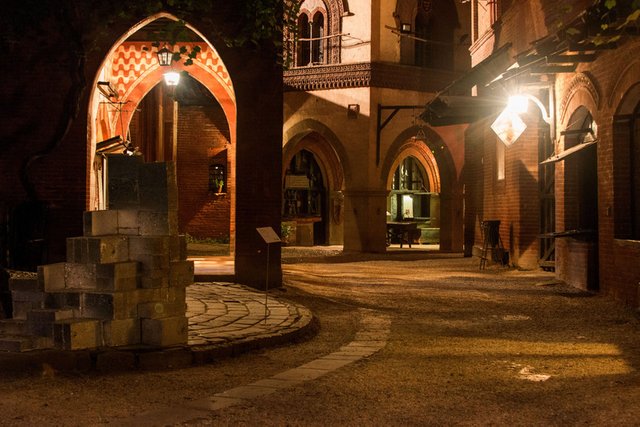
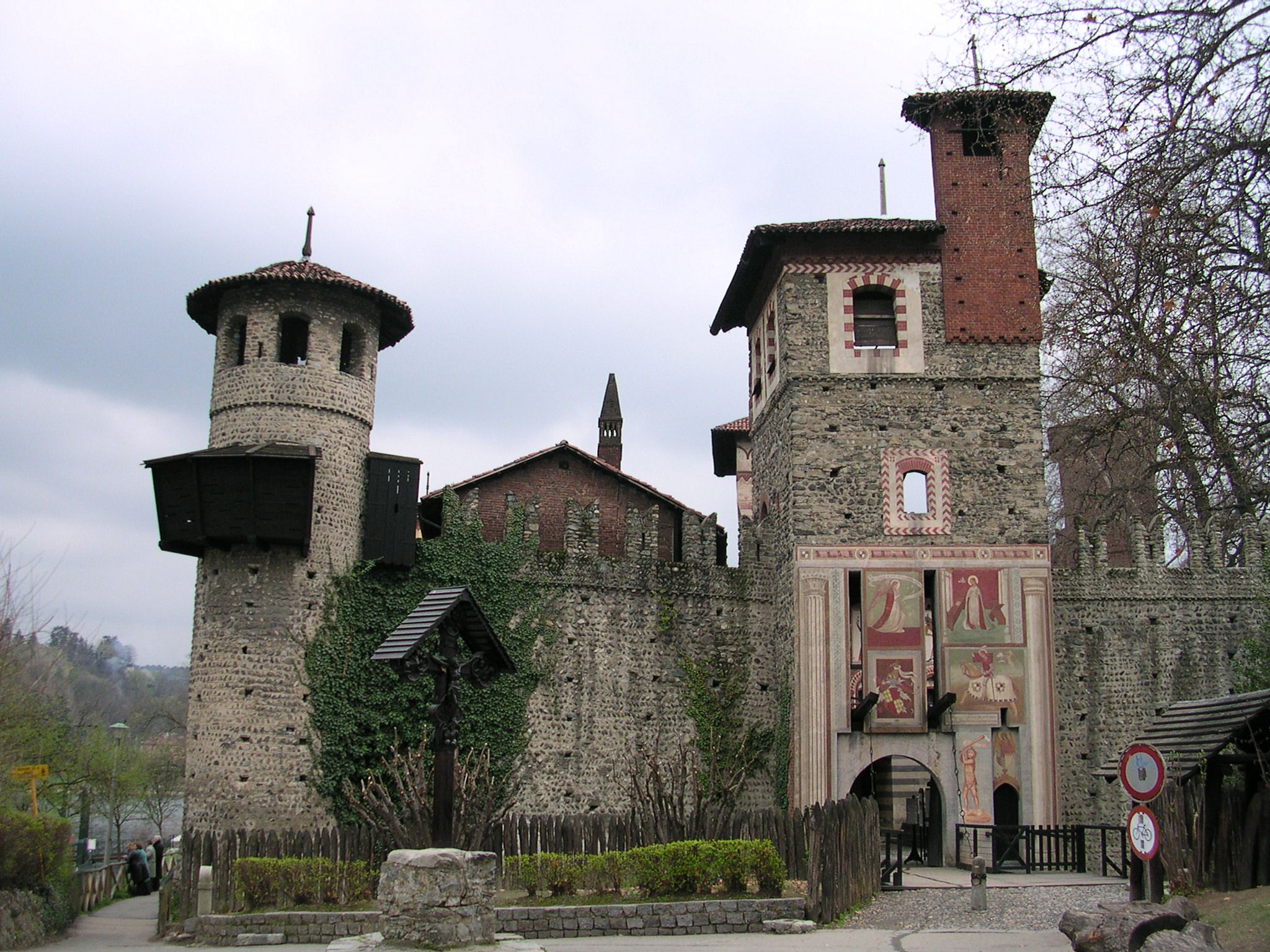
[it] La singolare realizzazione del Borgo Medioevale fu un prodotto della cultura positivista imperante nell'ultimo quarto dell'Ottocento, ma rifletteva anche l'attenzione al manufatto antico, alla cultura materiale del Medioevo, di cui Alfredo D'Andrade e Vittorio Avondo (anch'egli membro della Commissione) avevano già dato prova nel recupero e restauro di alcuni castelli valdostani, in particolare quello di Issogne, acquistato da Avondo nel 1872.
L'immane lavoro di reperimento e riproduzione dei modelli procedette a ritmo accelerato: il 12 dicembre 1882 si pose la prima pietra della Rocca (il castello), il 6 giugno 1883 si pose la prima pietra del villaggio, il 27 aprile 1884 il Borgo venne inaugurato alla presenza dei sovrani d'Italia, Umberto e Margherita di Savoia.
La Rocca era visitabile all'interno e i suoi ambienti completamente arredati riproducevano una dimora signorile del XV secolo; le case del villaggio erano poco più che quinte teatrali, fatta eccezione per la Casa di Avigliana, che ospitava la biglietteria e gli uffici, e per la Casa di Borgofranco, dove era ambientata la taverna con l'attiguo ristorante San Giorgio.
Sotto i portici si aprivano le botteghe artigianali, affidate a ditte di livello nazionale, che costituivano esempi di alta tradizione nella lavorazione della ceramica, del legno, del ferro e che animavano realisticamente la strada del villaggio.
All'inaugurazione del Borgo vi erano la bottega del vasaio, della tessitrice, dello speziale, del falegname, del fabbro, del ramaio, la bottega in cui si riproducevano oggetti artistici, l'"Osteria all'usanza antica" (con cibi medievali) e "l'Osteria all'usanza moderna" (con cibi contemporanei). Oltre alle botteghe, nei mesi di apertura dell’Esposizione del 1884 si trovavano anche negozi di rivendita di prodotti, per imitare la vita di un vero villaggio medievale. Oggi sono presenti le botteghe del fabbro e dello stampatore, oltre a un negozio di souvenir.
[en] The singular realization of the medieval village was a product of the positivist culture dominating the last quarter of the nineteenth century, but also reflected the attention to the ancient artifact, to the material culture of the Middle Ages, of which Alfredo D'Andrade and Vittorio Avondo (also Member of the Commission) had already begun to testify in the recovery and restoration of some Valdostan castles, in particular Issogne, purchased by Avondo in 1872.
The immanent work of retrieval and reproduction of the models proceeded at an accelerated pace: on 12 December 1882 the first stone of the Rocca (the castle) was laid, on June 6, 1883, became the first stone of the village, on 27 April 1884 the Borgo came inaugurated in the presence of the sovereigns of Italy, Umberto and Margherita of Savoy.
The Rocca was visited inside and its fully furnished rooms reproduced a stately home of the fifteenth century; the houses of the village were a bit more than a theatrical quintessence, except for the House of Avigliana, which housed the ticket office and the offices, and the Casa di Borgofranco, where the tavern was set up with the adjacent restaurant San Giorgio.
Under the arcades were opened the artisan workshops, entrusted to national-level companies, which were examples of high tradition in ceramic, wood and iron working and realistically animating the village road.
At the inauguration of the Borgo there was the workshop of the potter, the weaver, the carpenter, the carpenter, the blacksmith, the ramium, the shop where artworks were reproduced, the "Osteria all'alta antica" (with medieval foods) and "Osteria alla modernità" (with contemporary foods). In addition to the shops, in the opening months of the exhibition of 1884 there were also shops selling products to imitate the life of a true medieval village. Today there are blacksmith and printer shops, as well as a souvenir shop.
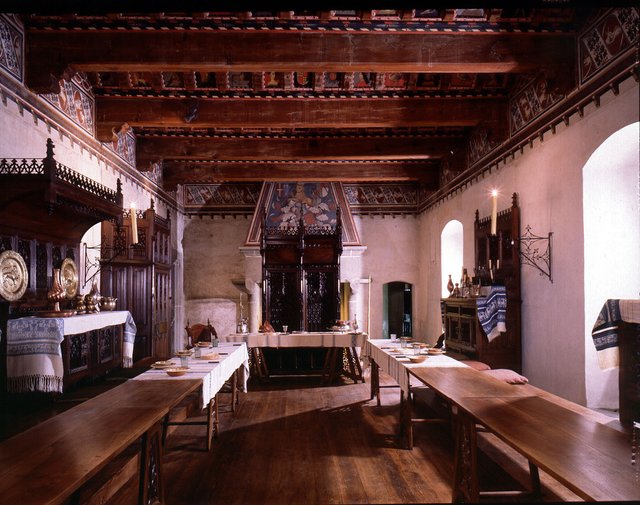
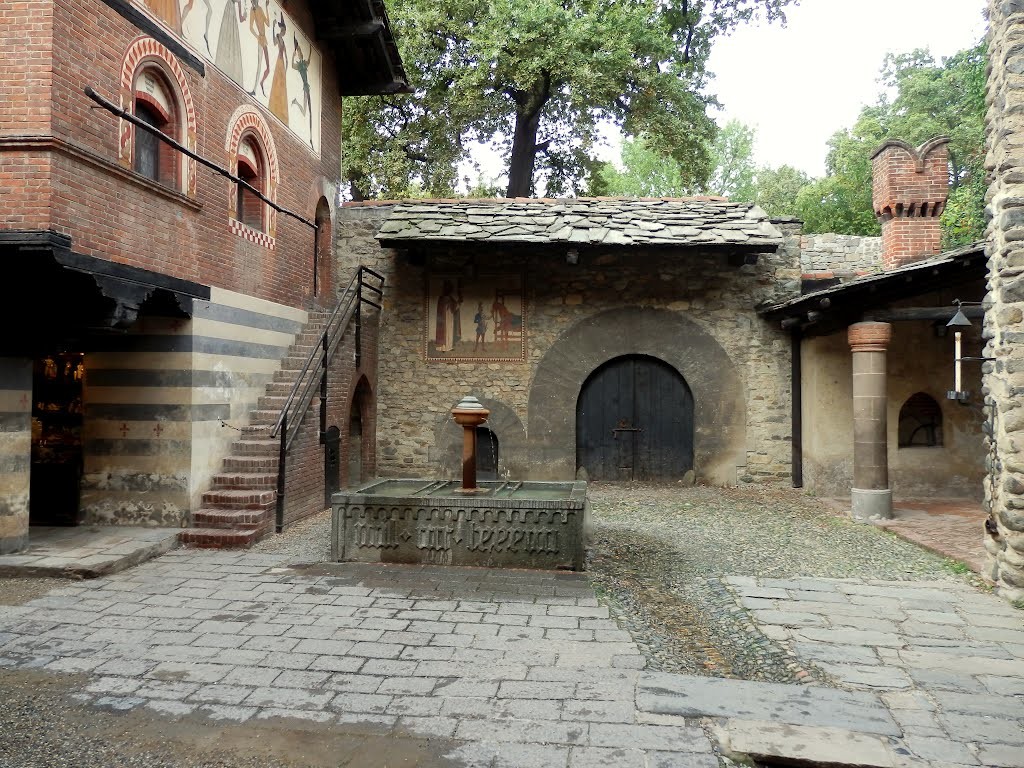
[it] La realizzazione del Borgo fu completata dalla Commissione preposta con la stesura di uno specifico catalogo uscito contemporaneamente all'Esposizione e intitolato: Catalogo ufficiale della Sezione storia dell'arte. Guida illustrata al castello feudale del secolo XV, stampato dalla tipografia Bona di Torino. Il catalogo non è una guida in senso stretto ma piuttosto uno strumento di studio e approfondimento che fornisce delle chiavi interpretative del complesso. È formato da tre sezioni di cui sono autori tre membri della Commissione: rispettivamente Giuseppe Giacosa, Alfredo D'Andrade e Pietro Vayra. Giacosa scrisse l'Introduzione, in cui analizzava le motivazioni più generali e profonde che hanno portato alla realizzazione del Borgo. Infine Pietro Vayra scrisse de La rocca, esaminando gli arredi e le suppellettili del castello e trattando analiticamente dei modelli e delle fonti documentarie che sono state alla base della loro realizzazione. La ristampa anastatica del catalogo è, oggi, disponibile, presso la biglietteria del Borgo Medievale.
Il Borgo Medievale è un caso unico all'interno del panorama artistico torinese, più simile ad un sito archeologico o monumentale che ad un museo in senso stretto formato da collezioni incrementabili. In effetti il complesso non nacque come museo, ma come padiglione dell'Esposizione generale italiana artistica e industriale, che si svolse a Torino dall'aprile al novembre del 1884. Mentre la Rocca, il castello, fu costruita per durare nel tempo, il villaggio era destinato alla demolizione, una volta che la manifestazione fosse terminata.
L'enorme successo ottenuto dal complesso fece sì che esso fosse acquistato dalla Città di Torino a fine manifestazione, entrando a far parte dei Musei Civici solo molto più tardi (le carte amministrative dicono dal 1942) e, dal 2003, della Fondazione Torino Musei.
[en] The realization of the Borgo was completed by the Commission responsible for the creation of a specific catalog published at the same time as the Exposition and entitled: Official Catalog of the History Section of Art. Illustrated guide to the feudal castle of the fifteenth century, printed by the Bona di Torino printing company. The catalog is not a guide in the strict sense but rather a study and study tool that provides interpretative keys to the complex. It is made up of three sections, of which three Commission members are composed: Giuseppe Giacosa, Alfredo D'Andrade and Pietro Vayra, respectively. Giacosa wrote the Introduction, in which he analyzed the most general and deep motivations that led to the realization of the Borgo. Finally, Pietro Vayra wrote of La Rocca, examining the furnishings and furnishings of the castle and analytically dealing with the models and documentary sources that underlie their realization. The catalog's anastatic reprint is available today at the ticket office of the Medieval Village.
The Medieval Borgo is a unique event in the Turin artistic landscape, more like an archaeological or monumental site than a museum in the narrow sense, made up of incremental collections. In fact, the complex was not born as a museum, but as a pavilion of the Italian General Art and Industrial Exhibition, which took place in Turin from April to November 1884. While the fortress was built to last for a long time, the village was destined for demolition once the event had ended.
The enormous success of the complex made it to be purchased from the City of Turin at the end of the event, becoming part of the Civic Museums only much later (the administrative papers say since 1942) and, since 2003, the Fondazione Torino Musei.
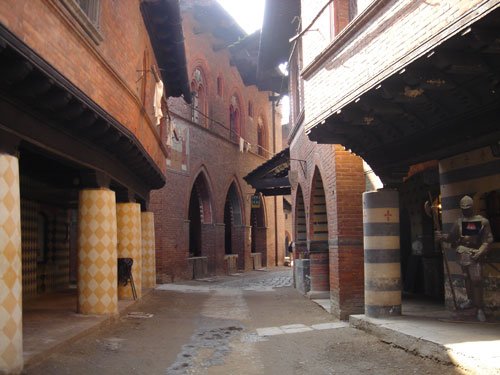
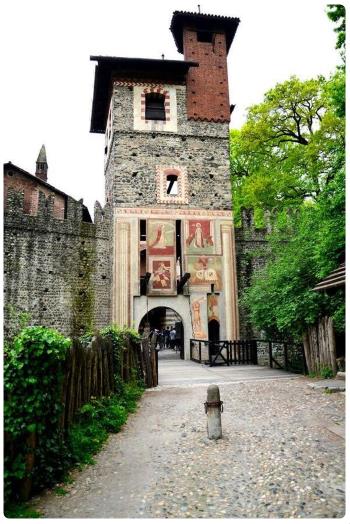
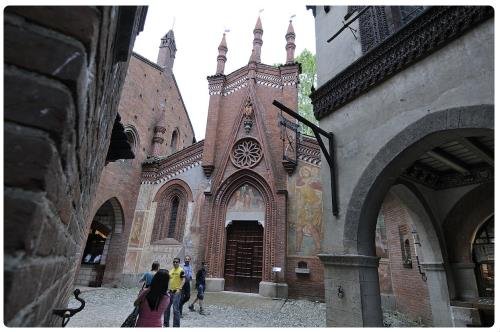
[it] Il 26 aprile 1884 si aprì a Torino nel Parco del Valentino l'Esposizione generale italiana artistica e industriale. Essa si collocava nella scia delle grandi manifestazioni di respiro internazionale, che intendevano promuovere la produzione industriale ancora agli albori in Italia. I modelli erano l'Esposizione di Londra del 1851 e quella di Parigi del 1878.
Si trattava di grandi eventi che fruivano di finanziamenti pubblici e che fondevano i caratteri della fiera-mercato tradizionale con quelli della presentazione di nuovi prodotti, e quelli ancora della mostra.
Queste manifestazioni, volte essenzialmente al futuro, all'innovazione, agli scambi di livello internazionale, erano però sempre corredate da padiglioni o strutture che illustravano la produzione artistica e architettonica dei secoli passati e delle più svariate civiltà.
Il Borgo Medievale è adagiato con naturalezza sulle rive del Po; l'atmosfera che si respira fra le sue case è magica e, allo stesso tempo, familiare, tutto è studiato per apparire assolutamente "vero". Grande cura e perizia furono posti nella scelta dei particolari costruttivi e vennero messi in atto tutti gli espedienti per ricevere il visitatore ed immetterlo in un mondo diverso rispetto all'ambiente circostante (nel 1884 l'Esposizione generale, in seguito il Parco del Valentino).
L'unica strada del villaggio si sviluppa tutta a zig-zag per apparire più lunga e offrire sempre nuovi scorci al visitatore; il chioccolio della fontana posta vicinissima al ponte levatoio segna uno stacco acustico per chi entra nel Borgo; le botteghe danno l'illusione di un villaggio vivo, vissuto. Molte discussioni si accesero all'interno della Commissione circa l'opportunità o meno di inserire personaggi in costume o manichini all'interno della Rocca, tanto si voleva ricreare l’illusione del “vero”. L'intento di creare un luogo pittoresco e illusivo non era però l'unica finalità che si ponevano gli ideatori del Borgo, anzi. I loro scopi erano innanzitutto didattici, educativi, di tutela del patrimonio storico-artistico piemontese e valdostano.
[en] On April 26, 1884, the Italian General Art and Industrial Exhibition opened in Turin in the Parco del Valentino. It was in the wake of the great international air show, which aimed to promote industrial production still in the early days of Italy. The models were the London Exhibition of 1851 and that of Paris in 1878.
These were great events that benefited from public funding and merged the characters of the traditional trade fair with those of the presentation of new products, and those still in the show.
These events, essentially for the future, innovation, international trade, however, were always accompanied by pavilions or structures that illustrated the artistic and architectural production of past centuries and of the most varied civilizations.
The medieval village is naturally nestled on the banks of the Po; the atmosphere that is breathed between its homes is magical and, at the same time, familiar, everything is studied to look absolutely "true". Great care and expertise were placed in the choice of constructive details and all the gimmicks were put in place to receive the visitor and enter it in a different world than the surrounding environment (in 1884 the General Exhibition, later the Valentine Park).
The only street in the village is all zigzag to appear longer and always offer new visitor visitor views; the chioccolio of the fountain near the drawbridge marks an acoustic detachment for those who enter the village; the shops give the illusion of a live, lived village. Many discussions took place within the Commission about whether or not to include characters in costumes or mannequins inside the Rock, so much so that one wanted to recreate the illusion of the "true". The intent of creating a picturesque and illusive place was not, however, the sole purpose of the village's creators, indeed. Their goals were first of all didactic, educational, protection of the Pemontese and Aragonese historical-artistic patrimony.
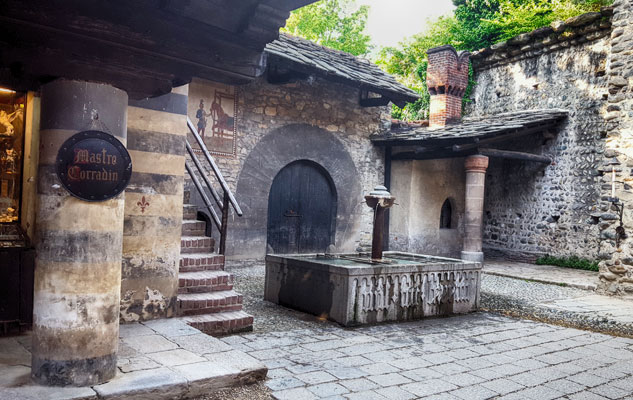
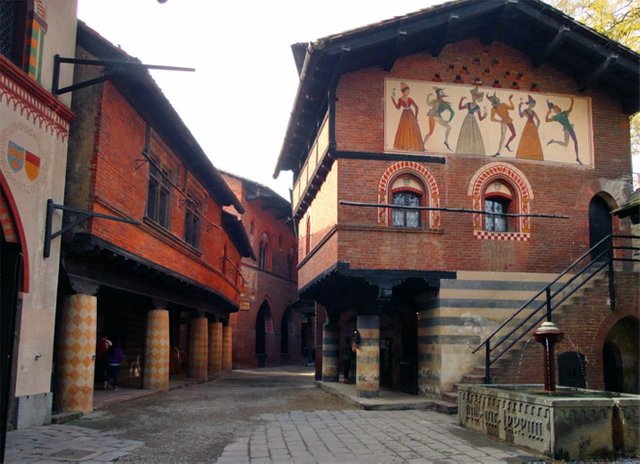
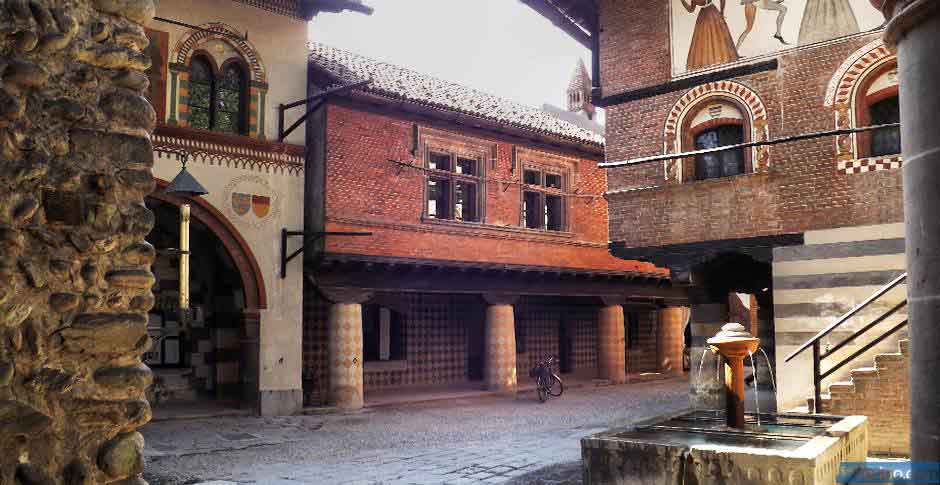
[it] Il gradimento del Borgo da parte del pubblico è stato vastissimo e ininterrotto. Fino agli anni Trenta del 1900 le finalità per cui il Borgo era stato realizzato erano ancora perfettamente comprese e condivise dall'ambiente culturale torinese. L'atteggiamento cambiò nel Secondo dopoguerra. In considerazione dei rilevanti danni derivati dai bombardamenti (venne colpita la parte sud del Borgo, con conseguente distruzione di parte della Rocca e della casa di Ozegna) fu addirittura ventilata l'ipotesi della demolizione del Borgo, poi fortunatamente abbandonata. E' infatti l'anno della mostra "Alfredo D'Andrade. Tutela e restauro", primo significativo segno del rinnovato interesse della critica per il neomedievismo piemontese della seconda metà dell'Ottocento. A partire da questa data il Borgo ritrova il giusto posto nel panorama culturale della città, anche grazie al suo uso mirato come sede di manifestazioni e eventi e alla ripresa di un’intensa attività editoriale e culturale. Il Borgo è, più volte nel corso dell’anno, sede di mostre temporanee all’aperto e nella sala mostre, nascosta dietro la facciata della chiesa: anche queste, legate a tematiche quali la città di Torino, il medioevo o il neomedievismo, godono di un buon successo di critica e di pubblico.
Nel borgo, All'interno delle mura merlate, oltre il ponte levatoio, le costruzioni del Borgo si susseguono lungo la via maestra, in un percorso estremamente suggestivo. Esse ripropongono edifici piemontesi e valdostani, accostati a costituire un nucleo abitato animato dalle botteghe artigiane. Dalla fontana alla tettoia del forno per il pane, dal laboratorio del maniscalco, all'Ospizio per accogliere i pellegrini. Dietro alla facciata della chiesa è da pochi anni allestita una sala mostre, dove, in determinati periodi, si propongono al pubblico esposizioni e allestimenti temporanei.
[en] The popularity of the village was vast and uninterrupted. Until the 1930s the purpose for which the Borgo had been realized were still perfectly understood and shared by the Turin cultural environment. The attitude changed in Second World War. In view of the significant damage caused by the bombings (the southern part of the village was struck, resulting in the destruction of part of the fortress and of Ozegna's house), the idea of demolishing the Borgo was well ventilated, then fortunately abandoned. This is the year of the exhibition "Alfredo D'Andrade, Protection and Restoration", the first significant sign of the renewed interest of critics for Piedmontese neo-mediaevalism of the second half of the nineteenth century. Since then, Borgo finds the right place in the cultural landscape of the city, also thanks to its use as a venue for events and events and the resumption of intense editorial and cultural activity. The Borgo is home to temporary exhibitions in the open air and in the exhibition hall, hidden behind the facade of the church, several times during the year. These are also linked to issues such as the city of Turin, the Middle Ages, or the neo-Meediate. of a good critical and public success.
In the hamlet, Inside the besieged walls, besides the drawbridge, the Borgo buildings follow the main road in an extremely impressive path. They reflect Piedmontese and Aragonese buildings, which are linked to a living nucleus of artisan crafts. From the fountain of the bread oven to the breadstock, from the lab's workshop to the hospice to welcome the pilgrims. Behind the facade of the church, a showroom has been set up for a few years, where, at certain times, temporary exhibitions and arrangements are set up.
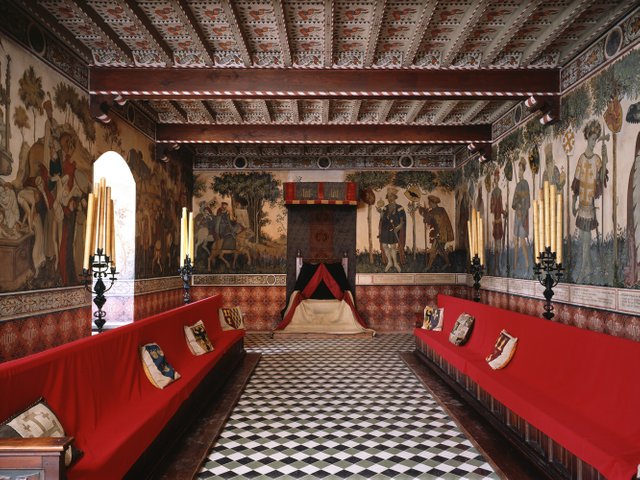
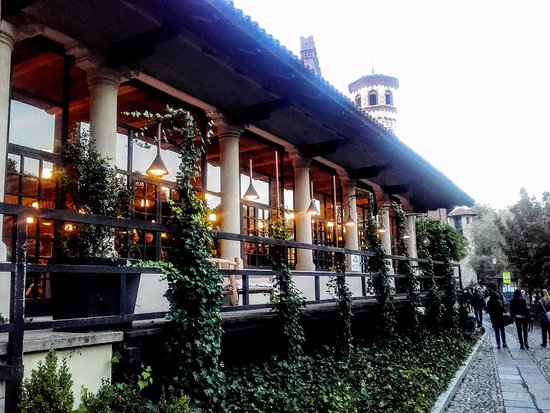
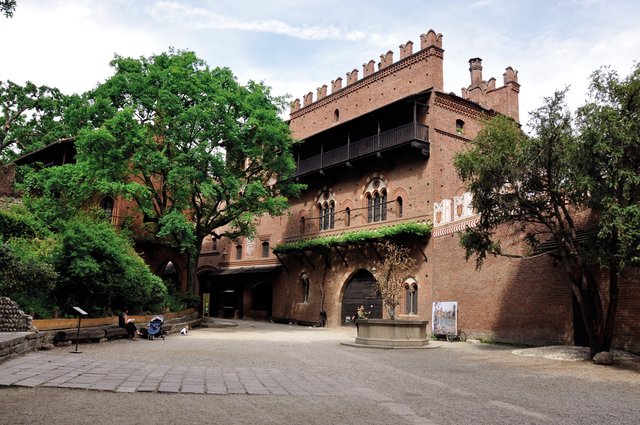
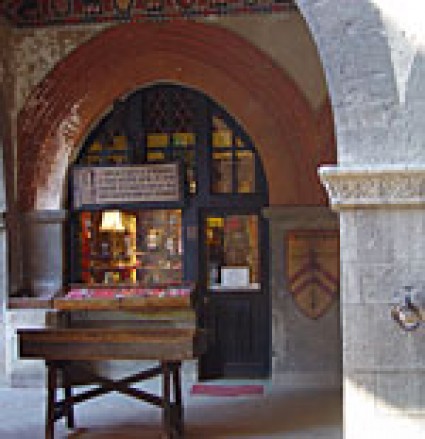
[it] La Rocca, costituisce il punto focale, elevato rispetto al percorso del Borgo. E' la dimora signorile fortificata, con stanze sontuose ricche di mobili, suppellettili, tessuti, a mostrare gli usi di vita del Quattrocento. Le corazze, le armi, i passatempi lasciati nel camerone degli uomini d'arme, la sala da pranzo, la cucina, offrono una idea davvero "palpitante e parlante" di un castello sabaudo del XV secolo. Oltrepassata la sala del trono, ove sfilano i Prodi e le Eroine, la camera da letto colpisce per il grande baldacchino dalle cortine ricamate; la cappella chiude il percorso.
Attraverso la tettoia delle armi da assedio, si può accedere agli spazi verdi del Borgo, dove, dal 1996, è stato riprodotto, in piccolo, un giardino medievale.
Il Giardino del Borgo Medievale di Torino si trova all’interno del Parco del Valentino e fa parte di un complesso museale aperto al pubblico di cui è possibile visitare la Rocca e il Giardino.
Costruito tra il 1997 e il 2000 il giardino è suddiviso in tre parti: il Giardino delle Delizie, la parte nobile annessa al castello con le piante ornamentali; il Giardino dei Semplici, con le piante officinali e utili, e l’Orto con alberi da frutto e ortaggi. Il giardino è gestito secondo metodi naturali di coltivazione (fertilizzazione, lavorazioni del terreno, trattamenti) ed è dotato di una piccola area vivaio per la conservazione di molte delle specie coltivate, mentre le piante eccedenti sono vendute al pubblico.
[en] The Rock is the focal point, high compared to the Borgo route. It is the fortified mansion, with sumptuous rooms full of furniture, furnishings, fabrics, to show the life-style of the fifteenth century. Armor, weaponry, hobbies left in the cameroun of armed men, dining room, kitchen, offer a truly "palpitating and speaking" idea of a Savoy castle of the fifteenth century. After passing the throne room, where the Prodi and the Heroes parade, the bedroom hits the large canopy with embroidered curtains; the chapel closes the path.
Through the canopy of the siege weapons, you can access the green spaces of the Borgo, where, since 1996, a small medieval garden has been reproduced.
The Giardino del Borgo Medievale in Turin is located inside the Valentino Park and is part of a museum complex open to the public of which you can visit the Rocca and the Garden.
Built between 1997 and 2000, the garden is divided into three parts: the Garden of Delights, the noble piece attached to the castle with ornamental plants; the Garden of the Simplified, with medicinal and useful plants, and the vegetable garden with fruit trees and vegetables. The garden is managed by natural methods of cultivation (fertilization, soil treatments, treatments) and has a small nursery area for the conservation of many of the cultivated species, while the surplus plants are sold to the public.
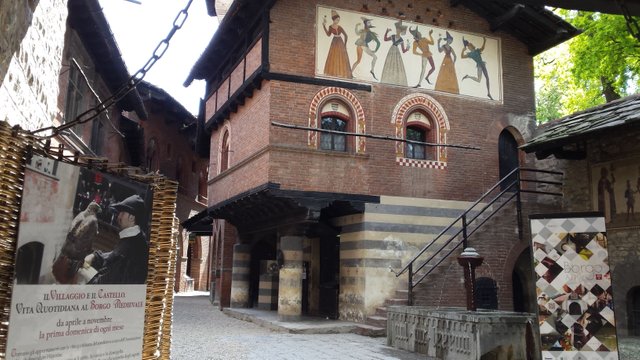
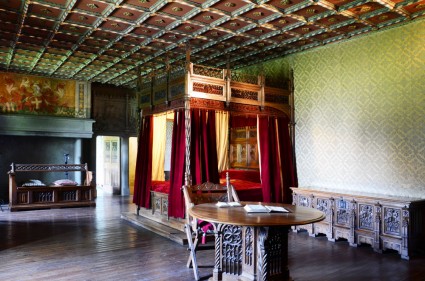
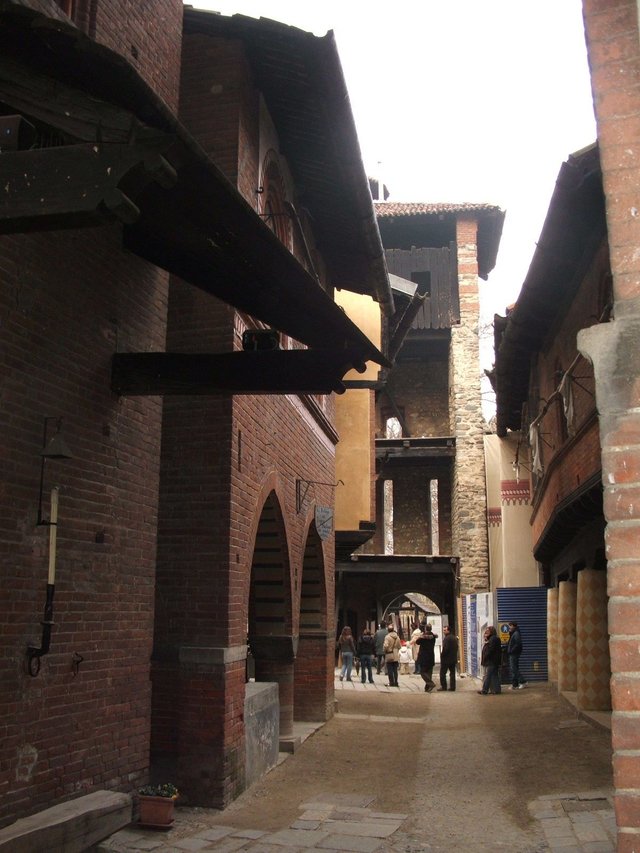
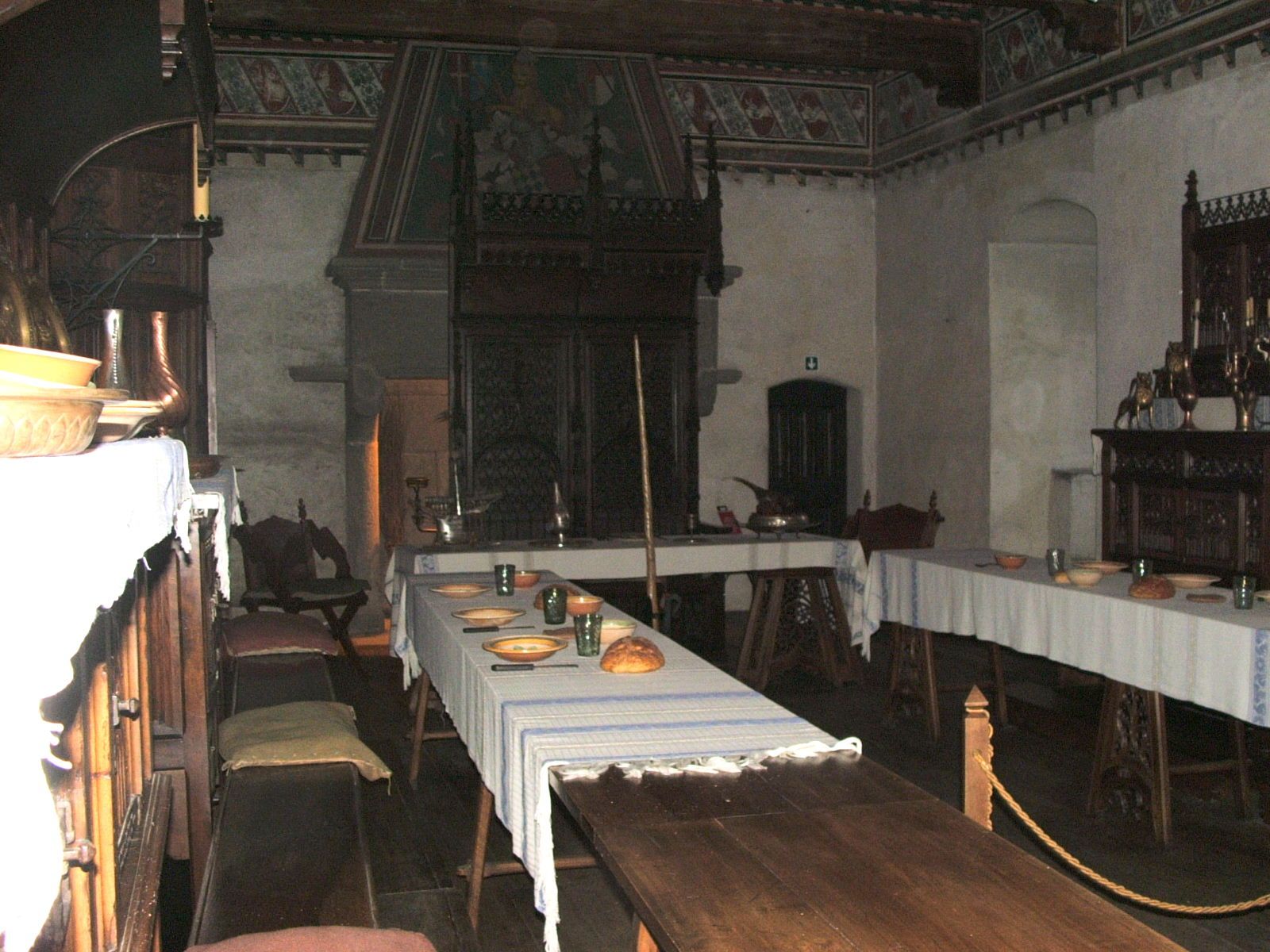
[it] Qualche curiosità:
POSA DELLA PRIMA PIETRA DELLA ROCCA:
12 dicembre 1882
POSA DELLA PRIMA PIETRA DEL BORGO:
6 giugno 1883
SUPERFICIE DEL BORGO MEDIEVALE:
8.550 mq (di cui 2.750 area coperta)
INAUGURAZIONE:
Il 27 aprile 1884 alla presenza dei sovrani d'Italia, Umberto e Margherita di Savoia.
VISITATORI DURANTE L'ESPOSIZIONE:
216.506
LOCALITÀ IN CUI SI TROVANO GLI EDIFICI CHE ISPIRARONO IL BORGO E LA ROCCA:
41
[en] Some curiosity:
FIRST STONE:
December 12, 1882
LOT OF THE FIRST STONE OF BORGO:
June 6, 1883
SURFACE OF MEDIEVAL BORGO:
8.550 sqm (including 2,750 covered areas)
INAUGURATION:
On April 27, 1884, in the presence of the sovereigns of Italy, Umberto and Margherita of Savoy.
VISITORS DURING EXPOSITION:
216506
LOCATION WHERE ARE THE BUILDINGS ISPIRARING THE BORGO AND ROCCA:
41
Loads of information. Thanks. Love it. @maxcar975 Followed
Thanks! Is a magic place in center of a special city. I suggest you visit her. Follow you too
@maxcar975 got you a $8.96 (4.0%) @minnowbooster upgoat, nice! (Image: pixabay.com)
Want a boost? Click here to read more about @minnowbooster!
The @OriginalWorks bot has determined this post by @maxcar975 to be original material and upvoted it!
To call @OriginalWorks, simply reply to any post with @originalworks or !originalworks in your message!
To enter this post into the daily RESTEEM contest, upvote this comment! The user with the most upvotes on their @OriginalWorks comment will win!
For more information, Click Here!
Special thanks to @reggaemuffin for being a supporter! Vote him as a witness to help make Steemit a better place!